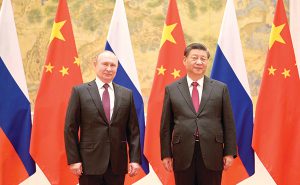Bloomberg
Russia’s invasion of Ukraine poses a difficult question for China: How can it support a key strategic partner when relations with the US and Europe are so much more important for its economy?
An important energy supplier to China, Russia has strengthened trade ties with Beijing over the past decade. However, Russia’s economic weight pales in comparison to Western nations, who are much bigger export customers for China, major sources of technology and investment, and also control China’s access to the international dollar system.
“For China, the economic relationship with the European Union is much more important than with Russia,†said Iikka Korhonen, head of the Bank of Finland Institute for Emerging Economies, which specializes in analysis of China and Russia. “That feeds into policy making that is cautious about what is happening in Ukraine.â€
For now, China has pledged to maintain normal trade with both Russia and Ukraine despite a ratcheting up of sanctions by the US, Europe and other Western allies, as well as by Asian economies like Japan and Taiwan.
The two countries set their bilateral relationship on a stronger footing in 2014 following Russia’s invasion of Crimea. Presidents Vladimir Putin and Xi Jinping agreed at the time on a “new stage in the China-Russia comprehensive strategic partnership,†signing deals on energy, electricity, aviation, telecommunications, and other areas.
Since then, Chinese imports from Russia jumped to a record $79 billion last year, driven mostly by energy purchases. China is a key market for Russia, buying 17% of its exports in 2020, behind only Europe.
Chinese exports to Russia also hit a record last year, although Russia makes up only 2% of shipments, about the same amount as Australia buys and well below the US’s share of 17%.
At a Xi-Putin meeting earlier this month in Beijing, the Chinese leader said the two countries should aim to raise bilateral trade to $250 billion from $140 billion last year. Still, on foreign direct investment, China’s inflows into Russia has generally been very low.
Another question facing China is how its companies will respond to US and European sanctions on Russia, including bans on exports of semiconductors and dual use or high-tech goods. U.S. allies such as Japan, Taiwan and South Korea — all key chipmaking countries — have either followed suit or indicated that they will. It’s uncertain whether Chinese companies which use U.S. technology, such as Semiconductor Manufacturing International Corp., will also cut off Russia.
Russia has been cutting the role of the dollar in its economy and trade since the imposition of sanctions following its invasion of Crimea.
The dollar’s share of Russia’s $640 billion foreign-currency reserves declined to 16% in 2021 from 46% in 2017. In comparison, the yuan’s share in reserves rose to 13%, from less than 3%, while the euro’s gained to 32% from 22%.
The US currency’s dominance in Russia’s trade payments has also diminished, with 56% of export receipts in dollars in the first half of last year, down from 69% in 2016, according to a study by UBS AG’s economist Anna Zadornova.
 The Gulf Time Newspaper One of the finest business newspapers in the UAE brought to you by our professional writers and editors.
The Gulf Time Newspaper One of the finest business newspapers in the UAE brought to you by our professional writers and editors.
